
Andrey Pospelov, Candidate of Historical Sciences, Associate Professor of Odesa Mechnikov National University, Full Member (Academician) of the International Academy of Life Safety
Weapons and Military Equipment for the Army of the Armed Forces of Ukraine. Part 2
When in January 1992 the Armed Forces of Ukraine (AFU) were being formed, the most favorable situation with weapons and military equipment (WME) was in the Army. Indeed, the three military districts of the former Soviet Army (Kiev, Odessa and Carpathian ones) nearly immediately transformed into the Northern (Central), Southern and Western Operational Commands, consisted of 22 divisions (4 tank, 14 motorized infantry, 3 artillery and 1 airborne) and 39 brigades (1 Special Forces, 2 air assault, 8 artillery, 12 missile, 9 anti-aircraft and 7 anti-tank). The Army aviation had 7 separate helicopter regiments[1].
Their weapons were also impressive not only due to their quantity, but also due to the quality:
- 6300 tanks (including T-80 — 300, T-72 — 1000, about 2200 T-64, other-modernized T-62 and T-55;
- 3686 infantry fighting vehicles (BMP-3 — 6, BMP-2 — 1250, BMD — 310, other — BMP-1);
- 8300 armored personnel carriers (mainly BTR-60PB, BTR-70 and BTR-80, but Airborne Forces had 100 BTR-D);
- 1165 self-propelled artillery systems (25 — 152-mm 2S5 “Hyacinth-S”, 10 — 152-mm 2S19 “Msta-S”, 100 — 203-mm 2S7 “Pion”, 80 — 120-mm 2S9 “Nona-S“ other 122-mm 2S1 ”Gvozdika” and 152-mm 2S3 ”Acacia“);
- 830 towed artillery systems (of which the most advanced 152-mm 2A65 “Msta-B” — 100 and 2A36 “Hyacinth-B” — 220);
- 470 mortars, with the caliber more than 120 mm (of which the most advanced 120-mm 2S12 “Sani” — 210);
- 531 rocket-artillery combat vehicle (50 — “Smerch”, 150 — “Uragan”, 313 — BM-21 “Grad”, 18 — 9P138 “Grad-1”);
- 132 launchers of tactical missiles R-17 (known in the West as SCUD) and 72 launchers of advanced tactical missiles “Tochka”.
To this should be added another 270 tanks, 320 infantry fighting vehicles and 160 pieces of artillery, with which were armed Coastal Missile-Artillery Troops, plus 265 armored personnel carriers and 60 pieces of the artillery belonging to the Marine Brigade.
Ukraine's Army's aviation had 693 helicopters, of which 240 were Mi-24 of various modifications[2].
These figures were significantly higher than the maximum allowable for Ukraine, according to the Agreement on the Common Armed Forces in Europe (which especially for CIS countries was amended by the Tashkent Protocol on May 15, 1992) — 4080 tanks, 5050 armored vehicles, 4040 artillery systems of more than 100 mm and 330 attack helicopters[3]. The real part of Ukrainian military equipment was smaller only for the last item.
It should be noted that in the situation of the “cold war” being over, the nature of war changing, and the international situation of that time being in general positive for Ukraine, Ukrainian Army did not need that much weapons and military equipment. Even with strict compliance with the above-mentioned Agreement, in terms of military equipment for the Army, virtually nothing would threaten Ukraine's security. However, the prospect of such a powerful arsenal had another side. Almost all of the samples of the military equipment of the Army were of the “third” postwar generation, that is, modern, as they were designed and produced in 1970s-1980s. A relatively small percentage of systems of the “fourth” generation (T-80 tanks, BMP-3, artillery systems “Hyacinth”, “Msta” and “Nona”, MLRS “Smerch”, “Uragan” and others) only complement the overall positive picture. First of all, because the neighbors of Ukraine either did not have appropriate analogues, or their number was also not significant. But the main thing was not even that, but first of all the fact that the ground WME were getting obsolete relatively slower than WME for the Air Force, Navy, and Air Defense. Moreover, the military-industrial complex (MIC) of Ukraine on almost all the samples had, if not a closed cycle of production, then of the repair — for sure. But what and how had to be upgraded — in the first half of the 1990s was not clear yet.
Only in the second half of the 1990s, and especially at the beginning of the 21st century there appeared a more or less scientific analysis of wars of the multi-polar world[4], and were determined the main and promising directions of Ukraine's military exports. And it was in this aspect that Ukrainian manufacturers of weapons and businessmen (government managers), using loopholes in the legal field of Ukraine, excess of WME in military units and at warehouses, as well as capabilities of our MIC, were forced to stick to the policy of arms exports, not to the policy of modernizing our Army. The result of this policy for the state as a whole was positive. Ukraine in the late 1990s, had become a major supplier of arms and military equipment for armed forces of many countries over the world. However, such a policy had a downside, which became apparent only in 2014.
The paradox of the current socio-political situation in Ukraine is that, despite the actual low intensity war going on in the Donetsk and Luhansk regions since the end of April 2014 (however, the victims of fighting in the Donbas are not adequate to the nature of the war and therefore the current anti-terrorist operation (ATO) can be considered a full-scale war), the vast majority of the citizens of Ukraine, even patriots are skeptical about the AFU and the MIC of Ukraine. Meanwhile, the domestic defense industry by its capacity, despite the enormous challenges, in general is not just up to the world standards, but in some aspects has much greater prospects in development than even the MICs of leading Western countries.
Let's try and discuss the problem, analyzing the situation on certain types of weapons and military equipment of the Army.
Small arms and light infantry weapons
In the context of Ukraine's ATO in the East, small arms and light infantry weapons serve almost the main type of weapons of subunits of AFU, National Guard, Ministry of Interior Affairs, Security Service, State Border Service and volunteer formations. At this, unlike other weapons, Ukraine not only had (theoretically) no problems with these means of war, but is able to fully meet the needs of its military units with pistols, rifles, machine guns, sniper rifles and even grenade launchers from two sources: from warehouses and plants.
Ironically, but for all the contradictions, this situation is almost unique in the history of wars. But then the current war in the East of Ukraine is in many ways also unique, first of all, because of the nature of its beginning and progress. As a result — our country's power structures' being absolutely practically, morally and psychologically unprepared for it. Therefore, it is in the sphere of small arms and light infantry weapons that was clearly seen all the inertia of thinking of the military, both at the front and in the rear, as well as of analysts and experts, conservatism and disability of the state machine, responsible for equipping troops with WME. And this despite the fact that at least theoretically, but the domestic industry in the field of small arms has done everything to get prepared for new (current) conditions.
Let's try to explain the situation in two aspects: theoretical and actual.
Today, the nature of wars has changed and, as a consequence — requirements to modern infantry armament. For example, in terms of the two world wars and military conflicts, preparation for a “hot war” of the era of global confrontation of military-political blocs (1946-1991) and various local conflicts of the recent past, from small arms and light infantry weapons were demanded simple construction (for mass production, including in a full-scale war on non-specialized enterprises), high rate of fire, practical fast firing and density of fire. These were explained by tasks to fight large masses of enemy's infantry under active offensive or defensive actions in open space. The light infantry weapons at the time were solving also actual supportive tasks: overlapping “dead” zones of firing artillery of various calibers, especially of armored vehicles accompanying the infantry, partly against lightly-armored targets and aircraft equipment by shooting special (armor-piercing, incendiary) bullets. At this, even a not very well trained soldier was supposed to use small arms.
Today at the forefront are actions of small special subunits of well trained soldiers in all conditions: urban, mountainous terrain, from cars, armored vehicles, helicopters, buildings, their roofs and basements. Tactics of such subunits resembles guerrilla and counter-guerrilla operations. That is why the weapon must “get used” to a specific soldier who can start an unexpected fire contact with the enemy, or vice versa, to conduct aimed fire on it. Therefore, among the requirements to modern weapons in the first place are questions of high accuracy of fire, size, weight and ergonomics of the weapon itself, including its bilateral symmetry (being used by both right-handers and left-handers). Another demand which emerged over the last 20 years — the ability to use with standard handguns weapons (even with pistols) various “gadgets”: bayonets, rifle scopes, including night ones, battle flashlights etc. This is achieved mainly with the help of Picatinny rails.
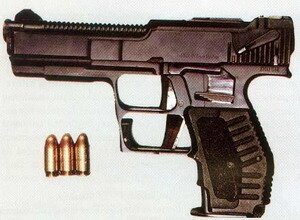 |
|
PSh pistol, developed by the Ukrainian designer V. Shevchenko http://pics.livejournal.com/ |
It should be noted that the Ukrainian manufacturers of weapons in mid-1990s, analyzed these changes in time and tried to respond promptly to new challenges. The prerequisite for this was a significant number of experienced designers working in institutions of the former USSR both, as whole collectives and individually, on public order and on their own initiative[5]. However, enterprises specialized in the development and manufacture of small arms until 1991 in Ukraine did not exist.
However, even in theory, it was not a serious problem, because despite the enormous variety of serial and experimental models of small arms, developed, tested and applied in many countries, the further course of its development was hampered by two factors due to which the development of this kind of equipment went through a serious crisis. We are talking about the limitations of existing ammunition (bullets and, above all, cartridges) and practically suitable for mass armed forces schemes of small arms.
As for cartridges, then there were the so-called “Soviet” and “NATO” standards. For pistol bullets — 9x18 PM and 9x19 PARA; for submachine guns — Soviet 7.62x39 and 5.45x39 and NATO's 7.62x51 and 5.56x45 cartridges. Same for heavy machine guns — 12.7x108 DShK and 12.7x99 Browning. Oddly enough, but to develop a cartridge and bullet of a new type was extremely difficult, and it is not beneficial from an economic point of view, first of all, because the main characteristic of the cartridge is not its fighting qualities, but the ability to be stored for years.
All attempts to create a so-called “caseless” cartridges or cartridges where liquid or gas is used instead of gunpowder, in practical terms, virtually had led to nothing (except for the German assault rifle G11, with which in limited numbers in 1988 was armed Bundeswehr). Bullets of standard forms have not been replaced so far either. For Ukraine, where there was a powerful enterprise of actually all-USSR importance — Luhansk Cartridge Plant, any “perturbations” with ammunition for small arms were not profitable and technically risky according to all forecasts. And this despite the fact that Ukrainian weapon-smiths were ready to venture into completely new directions in this sphere. Some practical steps have been taken in this direction, which can be confirmed by the fact that after the capture of the Luhansk enterprise by terrorists of LPR (Luhansk People's Republic), in August 2014, its equipment was dismantled and transported to Russia.
Besides, the main feature of the Soviet small arms and their ammunition was its capability to long-term (for decades) being kept until “time X”. That is why the warehouses in the territory of Ukraine were filled with a variety of small arms, counted by hundreds of thousands of units, including officially decommissioned samples (e.g. TT pistols and machine guns RPD-46). Cartridges of various calibers were counted by billions. Official data on arms and ammunition stored in Ukraine had not been published. The author can judge only from statements of officers with whom he had conversations at the informal level, such as, — “the stores of the N garrison alone are able to provide all the AFU for the next 10 years”).
However, at high propagation characteristics of the samples of the Soviet small arms — pistols PM, submachine guns AK-47 and AK-74 of different variations and modifications, machine guns PK, RPK, DShK, NSV and KPV, their shortcomings were also well known. And taking into consideration the fact that even the world-famous Kalashnikov submachine gun by the beginning of Ukraine's independence, had been serially produced and actively sold by nearly 40 countries, the export potential of the weapons stored in Ukraine was not high. Besides, for our state most important was not preparation for a full-scale war (for it, if necessary, were not only the stored weapons in sufficient quantity, but even the system of training infantry soldiers at school lessons on pre-conscription training of boys), and participation of Ukrainian soldiers in peacekeeping and special operations, was putting forward new demands to small arms.
The leadership of relevant structures of Ukraine understood this clearly as early as 1991, when in Vinnytsya was founded Science-Industrial Association “Fort” of Ministry of Internal Affairs of Ukraine. Simultaneously in Kiev appeared Design Bureau for Special Equipment (KB-ST) headed by Professor Ihor Alekseyenko (unfortunately, in a decade, the company collapsed). These enterprises immediately caught not only the trends in the world's arms market, but gaps in equipping national security agencies with them. I mean the urgent replacement of Makarov pistol (PM) and arming special purpose subunits with pistol-carbines. A promising task was creation of the newest submachine gun instead of the famous AK (among the main requirements was the scheme “bullpup” to reduce weight and size, to increase the accuracy of fire), and various sniper rifles.
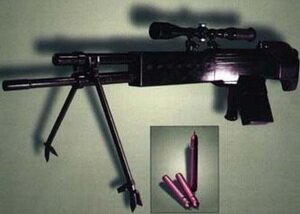 |
|
Not accepted for service in the AFU, 13-mm sniper rifle “Askoria” http://pics.livejournal.com/ |
As a consequence, were adopted pistols Fort-12, Fort-14 and Fort-21; developed pistol-carbines “Gnom”, “Elf” and “Goblin”; submachine guns “Vepr” and “Malysh”. The latter were not adopted because of the collapse of the KB-ST. At the stage of experimental samples remained Shevchenko pistol, pistols of the series “Khortytsya” (later they were adopted by the Armed Forces of Ukraine) by Zaporizhzhya designer M. Korolyov, a very special (for special cartridges) 13-mm sniper rifle “Askoria”. All these developments clearly demonstrated — the newly created production of small arms in Ukraine is able to create original designs, fully meeting modern requirements, both, for “Soviet” and for the “NATO” ammunition. Moreover, in Ukraine there is a potential for transition to a fundamentally new schemes of both small arms and ammunition[6].
The new stage of development of the industry for the production of small arms came at the beginning of the 21st century. It was during this period that appear a few companies for development and manufacture of small systems, and a number of other companies which had not been making small arms before, begin to work in this field. In 2014, the total number of companies in this sector in Ukraine has reached 20[7].
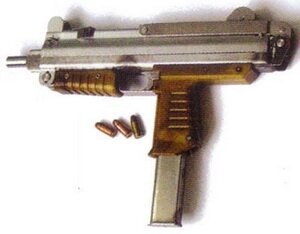 |
|
Ukrainian pistol-carbine TASKO 7ET10 for 9x19 PARA cartridge http://world.guns.ru/ |
Among the most powerful and promising enterprises for production of small arms in Ukraine, apart from the “Fort” are Kiev company “Mayak Zbroyar” (Lighthouse Gunsmith) and TASKO. They offered to arm the security agencies of Ukraine with several pistol-carbines (TASKO 7ET10 Fort-224) and sniper rifles (7.62-mm VPR-308, Z-008 and 12.7-mm TASKO 7ET3), the characteristics of which fully meet modern requirements. A characteristic feature of these models is their absolute fitting the ammunition of both NATO and former USSR, are notable for precision and quality of production, and a proved design.
Other Ukrainian enterprises of the above-mentioned sphere have begun to modernize the existing small arms (Nizhynskyi Arsenal of the Main Missile and Artillery Directorate of the Ministry of Defense of Ukraine, the Scientific Center of Precision Engineering of the National Space Agency of Ukraine /at Kiev Radio Factory/), and produce its special samples (The Plant of High-Precision Mechanics in Kamenets Podilskyi — 12.7-mm and 7.62-mm machine guns for armored vehicles).
However, due to a number of purely technical and especially financial difficulties, it was impossible to have made the mass production of new or upgraded models of small arms by the beginning of 2012. Thus, the company “Fort” had been annually producing only 500 pistols, of which the AFU, the Interior Ministry and SBU had been buying no more than 3-5%. And this despite the fact that the resource of the barrel alone of new Ukrainian pistols is 10 times higher than that of the famous Soviet Makarov Pistol.
That is why, at the turn of the first decades of the 21st century, there was a need to equip power structures of Ukraine with fundamentally new models of small arms, which would allow the reformed Ukrainian Army to be among the most advanced in the world. This was possible only if had been bought licenses for production of promising models of Western countries. Although Ukrainian producers' know-hows were also impressive. For example, the submachine gun “Uravnitel”, in which with the standard scheme of removal of powder gases from the barrel has been solved the important problem in the modern arms production — increase of density of fire with no additional effort of the shooter.
The relevance of this understanding was explained by the fact that the orientation on Russian (in fact, Soviet), samples was no longer justified.
Firstly, in terms of technology, powerful small arms production of Russia since the collapse of the Soviet Union has not offered anything (as well as in other sectors of the MIC***, for example tank construction), apart from pistol-carbines for special forces. At this, Ukrainian counterparts by their characteristics were not worse, and even better technologically than Russian ones.
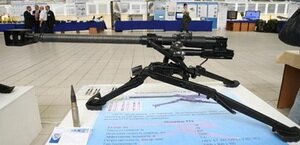 |
|
30-mm single-shot mounted gun SP http://s017.radikal.ru/ |
*** A striking illustration of this can serve this sample of small arms or artillery weapons, that was produced in 2013 by gunsmiths of the world-famous Izhevsk Machine-Building Plant (according to other sources — Tula Instrument-Making Design Bureau) — 30-mm single-shot mounted gun SP. How, for what and where to use it in modern conditions — it is not clear even to experts... http://strangernn.livejournal.com/1059071.html
Secondly, Western countries have taken leading positions in the development, production and practical use of special sniper weapons. Besides, thanks to the creation of a number of promising samples, small arms production of Western countries has found the way out from the technology crisis. That is why the Ukrainian MIC had to catch “the train that has just turned up”.
Proceeding from these considerations, enterprises “Fort” and “Mayak-Zbroyar” buy licenses for the appropriate small arms and run it in the series. Troops receive small numbers of sniper rifles — 7.62-mm MZ-10 (licensed version of the American AR-10), and the National Guard, the Security Service and State Border Service get 7.62-mm Fort-301 (licensed version of the Israeli Galil Sniper). Both rifles are designed to support subunits at a distance of 1 km.
Operational and physical characteristics of 7.62-mm sniper rifles taken into service in units of the Armed Forces of Ukraine, SBU and the Ministry of Internal Affairs:
|
|
MZ-10 |
Fort-301 |
|
Analogue |
AR-10 (USA) |
Galatz/Galil Sniper (Israel) |
|
Weight, kg |
6,2 |
6,8 |
|
Length, mm |
1200 |
1110 |
|
Barrel length, mm |
510 |
584 |
|
Muzzle velocity, m/s |
780 |
820 |
|
Sighting range, m |
800 |
1000 |
|
Magazine capacity, cartridges |
10/20 |
20 |
|
|
VPR-308 |
Z-008 |
Sako TRG-42 |
|
Weight, kg |
5-7 |
6 |
5,1 |
|
Length, mm |
1230 |
n/a |
1200 |
|
Barrel length, mm |
650 |
650 or 710 |
690 |
|
Sighting range, m |
900 |
800 |
1000 |
|
Magazine capacity, cartridges |
5/10 |
5 |
5/10 |
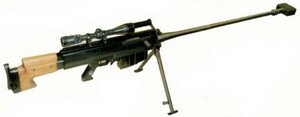 |
|
The 12.7-mm Ukrainian sniper rifle TASKO 7ET3 http://feduk.com.ua/ |
At the same time, for special and antiterrorist subunits of Ukraine was adopted a 12.7-mm semi-automatic sniper rifle TASKO 7ET3. It is designed to destroy hardened targets at long range, and is used with a variety of sights. By its characteristics, this weapon fully corresponds to the best world analogues, however, it is inferior to them in the weight.
Operational and physical characteristics of the ТАSКО 7ЕТ3 sniper rifle and its analogues:
|
|
TASKO 7ЕТ3 |
AI AS50 |
Barrett M82A3 |
OSV-96 |
|
Weight, kg |
16 |
14,1 |
14 |
12,9 |
|
Length, mm |
1500 |
1369 |
1448 |
1746 |
|
Barrel length, mm |
900 |
692 |
737 |
1000 |
|
Muzzle velocity, m/s |
n/a |
n/a |
853 |
900 |
|
Sighting range, m |
2000 |
2000 |
1800 |
1800 |
|
Magazine capacity, cartridges |
5 |
5 |
10 |
5 |
 |
|
One of the options of 5.56-mm assault rifle Fort-221 http://www.fort.vn.ua/ |
The real revolution in the manufacture of small arms in Ukraine occurred in 2011, when the company “Fort” acquired in Israel a license to manufacture assault rifle “Tavor” which was renamed “Fort-221” of 5.56-mm caliber. This weapon is made on a “bullpup” scheme and in practical terms, demonstrates high accuracy and fire precision, excellent functional reliability in extreme conditions, excellent ergonomics and comfort of use, secrecy. As compared with the AK 74, Fort-221 is more compact and ergonomically suitable for use both, in infantry ranks and from vehicles. Bipods legs provide a much better condition to fire from cover (mainly at checkpoints, which is important in today's conditions of the ATO) or in the lying position. Using new materials in the manufacture of this rifle opens prospects for further reduction of its weight and, if necessary, — size without losing its shooting characteristics.
Operational and physical characteristics of the 5.56-mm “bullpup” assault rifles:
|
|
Fort-221 |
Tavor TAR.21 |
Steyr AUG |
FAMAS G2 |
|
Weight, kg |
3,9 |
3,2 |
3,9 |
3,8 |
|
Length, mm |
645 |
640 |
745/715 |
757 |
|
Barrel length, mm |
375 |
380 |
455/407 |
488 |
|
Muzzle velocity, m/s |
890 |
890 |
990 |
925 |
|
Sighting range, m |
500 |
550 |
650/500 |
450 |
|
Technical rate of fire, rds/min |
1000 |
900 |
750 |
1000-1100 |
|
Magazine capacity, cartridges |
30 |
30 |
30 |
30 |
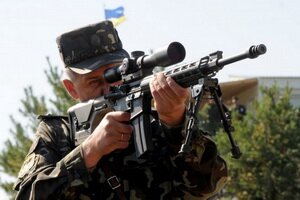 |
 |
| Army officers of Ukraine are testing the assault rifle MZ-15 (during shooting and partial disassembly). Differences with the AK are seen immediately... | |
| http://sfw.so/uploads/ | http://sfw.so/uploads/ |
At the same time, the company “Mayak-Zbroyar” began in this “NATO” caliber to produce the adopted in the AFU, assault rifle MZ-15, which is a licensed and upgraded version of the American AR-15/M-16. The rifle was tested in 2012-2013 and began to be supplied to airborne units. After the beginning of the mass production this weapon is planned to replace the Soviet 5.45-mm AK-74M. The rifle is made by the classical scheme and has a number of advantages, among them — its small weight, due to the use of composite materials; telescopic gun-butt, allowing the weapon to fit a particular shooter; modern sighting devices, e.g. — collimator sight that does not need batteries; Picatinny rail for hanging various gadgets.
Comparison of the assault rifle MZ-15 with the main 5.56-mm analogues:
|
|
MZ-15 |
M16A4 |
M4A1 |
SG550/556 |
AK5 |
G36 |
|
Weight, kg |
2,27-2,88 |
3,4 |
2,68 |
3,4-4,1 |
3,9 |
3,5-3,63 |
|
Length, mm |
986 |
1000 |
840 |
876-998 |
1008 |
998 |
|
Barrel length, mm |
508 |
510 |
370 |
528 |
450 |
480 |
|
Muzzle velocity, m/s |
975 |
848 |
884 |
900-980 |
930 |
920 |
|
Sighting range, m |
600 |
600-800 |
600 |
500-650 |
400 |
800 |
|
Technical rate of fire, rds/min |
950 |
950 |
950 |
700 |
650-700 |
750 |
|
Magazine capacity, cartridges |
30 |
20/30 |
30 |
20/30 |
30 |
30 |
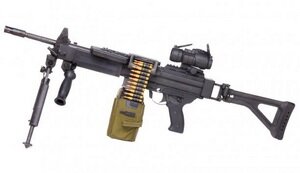 |
|
Machine gun Fort-401 http://www.fort.vn.ua/ |
An addition to the system of personal weapons for the troops of Ukraine becomes the 5.56-mm machine gun Fort-401, which is a licensed version of the Israeli “Negev”. Unlike the Soviet RPK (which actually was just a larger, due to the heavier barrel, AK-74), Fort-401 is precisely the machine gun. Its main advantage is using not a magazine, but a tape for 150-200 cartridges, both, from standard boxes and from assault (fabric) cylinder. This ensures a high rate of fire, range and accuracy of fire. The design also allows to use this weapon both, from bipods, and from the shooter's hands, as well as to mount it on different vehicles — from motorcycles to helicopters, and with Picatinny rail — to use any tactical accessories. There is a modification of a machine gun, Fort-401 for NATO cartridge 7.62x51 (based on the developed in Israel in 2012 machine gun Negev NG7).
Comparison of operational and physical characteristics of 5.56-mm and 7.62-mm machine guns Fort-401 and its analogues:
5.56-mm machine guns
|
|
Fort-401 |
Negev |
FN Minimi |
|
Weight, kg |
7,4 |
7,4 |
6,56/6,85 |
|
Length, mm |
890 |
890/1020 |
1040 |
|
Barrel length, mm |
330/460 |
330/460 |
349/465 |
|
Muzzle velocity, m/s |
800 |
850/915 |
865/925 |
|
Sighting range, m |
500/1000 |
800/1000 |
600/800 |
|
Technical rate of fire, rds/min |
850-1050 |
850-1000 |
700-1150 |
|
Magazine capacity, cartridges |
30 |
30/35/50 |
30 |
|
Ammunition belt capacity, cartridges |
150/200 |
150/200 |
100/200 |
7.62-mm machine guns
|
|
Fort-401 |
Negev NG7 |
Minimi |
|
Weight, kg |
8,1 |
7,6 |
8,17/8,4 |
|
Length, mm |
890 |
1000 |
1000/1015 |
|
Barrel length, mm |
330 |
508 |
502 |
|
Muzzle velocity, m/s |
840 |
915 |
925 |
|
Sighting range, m |
1000 |
1000 |
1000 |
|
Technical rate of fire, rds/min |
1000 |
850-1150 |
680-800 |
|
Ammunition belt capacity, cartridges |
200/300 |
100/125 |
100/200 |
Having adopted new infantry weapons systems in 2011-2013, Ukraine has not only made a big step in the transition to NATO standards and qualitative transformation of the range of exports of small arms, but also to the complete exclusion from the troops of the Soviet type of weapons that will give units of the AF of Ukraine fundamentally new quality. However, Ukraine has not managed to start mass production of these weapons at the only two plants that we have. And despite the fact that even India (also having a license to issue rifles “Tavor”) due to the higher culture of production of small arms in Ukraine, has announced its intentions to buy Fort-221 from our state.
However, if the latest models of small arms did get into the ATO zone, they got there in small quantities and only into the hands of well-trained special units. Proof of this is the LPR and DPR's militants' reports, in which the newest Ukrainian weapons as trophies are not mentioned. Partly, the non-use of the latest small arms systems of Ukrainian make in the ATO zone is due to lack of ammunition of caliber 5.56-mm, which so far has not been produced massively in our country. And since the Luhansk Cartridge Plant got under the control of the LPR, the problem has been only getting worse.
It is not surprising that the management of the Ministry of Defense of Ukraine, as an alternative, is seriously considering using in the Ukrainian Armed Forces of obsolete RPD-46 machine guns and modernization of this special, but, withdrawn from the troops in the early 1970s, weapons[8]. More so, as there was a precedent — in 2009, the Ukrainian Police again received into service from special warehouses the TT pistol. This “machine-gun alternative” actually is an original and effective way out from the difficult situation on the equipment of the ATO units with machine guns, especially because the warehouses have enough ammunition for them. Effective, primarily because by its combat characteristics RPD-46 surpasses the RPK, and by ideology — it is the analogue of Fort-401. Also, this will not just allow to prepare the appropriate personnel, but also to develop in combat conditions the principles and tactics of using units with heavy weapons capacity machine guns. Moreover, the need for such weapons on the world market is also quite considerable.
 |
|
40-mm universal automatic grenade launcher UAG-40 http://zbroya.info/ |
A new and no less promising direction in the production of Ukrainian weapons, by the way, is (fully consistent with global trends) the development and production of infantry grenade launchers. Today in the AFU is adopted only one such sample — 40-mm automatic grenade launcher UAG-40, — development and production of the Kiev shipyard “Leninska Kuznya” (“Lenin's Smithy”). It is designed to NATO standards (40x53) and is a replacement for the famous Soviet 30-mm AGS-17 “Plamya”.
Comparison of operational and physical characteristics of serial 40-mm automatic grenade launchers:
|
|
UAG-40 |
Mk47 |
HK GMG |
Vektor |
|
Weight of the grenade launcher /with the mount/, kg |
17/31 |
18/41 |
28/46,7 |
18/33,1 |
|
Length, mm |
960 |
940 |
1180 |
861 |
|
Sighting range, m |
2200 |
2200 |
2200 |
2200 |
|
Technical rate of fire, rds/min |
400 |
300 |
350 |
320 |
 |
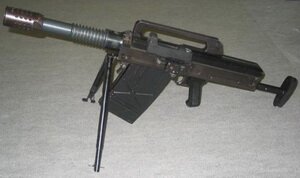 |
| Experimental Ukrainian manual automatic grenade launchers Valar-30 and RG-1 are the next generation of light infantry weapons | |
| http://ic.pics.livejournal.com/ | http://ic.pics.livejournal.com/ |
However, in the arsenal of Ukrainian weapon makers there is more than just this sample. Thus, at the end of the 1990s, the KB-ST developed a 24-mm grenade launcher with a fundamentally new technical solution of ammunition. At the same time the Ivano-Frankivsk enterprise “Valar” developed its own Valar-30 automatic grenade launcher under the Soviet 30-mm VOG-17 (under “NATO” caliber — Valar-40) and Dnipropetrovsk state enterprise “Southern Machine-Building Plant” — 30-mm RG-1 “Porshen”. The ideology of the last two automatic grenade launchers resembles that of a machine gun. Moreover, the state enterprise “Pavlograd Mechanical Plant” has begun to actively develop at least three fundamentally new types of 30-mm ammunition specifically for promising manual, automatic grenade launchers. All these developments make it possible to abandon the quite effective by fighting qualities, however, extremely heavy and difficult to use AGS-17 and to give Ukrainian units completely new features. In fact, is being created a whole direction of the organization of small-caliber artillery in platoons and companies, which even in the leading countries of the world is so far at the stage of theoretical justification.
So, the youngest branch of the Ukrainian MIC — production of small arms — in a very short period of time has covered the distance from the formation to entering world positions.
Samples, designed by Ukrainian weapon-makers, are not inferior to the best foreign analogues, and by their characteristics are significantly higher than the Soviet ones. The exception may be the only pistols (but they are not the main modern weapons) and, partially, pistols-carbines (although they are now only special weapons). Bulk supply with modern small arms of units and AFU, National Guard, Ministry of Internal Affairs and volunteer battalions will not only significantly change the ideology of the use of special, airborne and standard infantry units, but will also qualitatively raise their combat effectiveness, especially in the ATO zone.
Interestingly, for mass supplies of new weapons to Ukrainian troops there are no obstacles of a technical or technological nature. The only obstacle here is financial and bureaucratic problems (e.g. lack of decisions on increasing the output of modern small arms, as well as on allocation of the necessary funds for it). However, even such obstacles must be overcome as quickly as possible, because the export potential of the Ukrainian manufacture of small arms is already (theoretically) very high. However, before we talk about the export, we need immediately address the main task of Ukrainian weapon-makers — quality re-equipment of domestic law enforcement departments, especially those who are now fighting or will fight in the East of the country — in the ATO zone.
Notes:
Operational and physical characteristics of latest models of small and light infantry weapons are presented using information from the following online resources:
- http://eizvestia.com
- http://www.fort.vn.ua
- http://forum.milua.org
- http://liveguns.ru
- http://www.lk.com.ua
- http://www.mayak.com.ua
- http://pikabu.ru
- http://sniper-weapon.ru
- http://www.tasko.net.ua
- http://wartime.org.ua
- http://weapons-world.ru
- http://world.guns.ru
1. Feskov VI, Kalashnikov KA, V. Golikov. The Soviet Army in the years of the “Cold War” (1946-1991). — Tomsk: Tomsk State University, 2004.
2. Data from the special edition of the Sumy Artillery School “Armed Forces and arms of the CIS countries“ (restricted), 1992.
3. The Treaty on Conventional Armed Forces in Europe /https://ru.wikipedia.org/wiki/%D0%94%D0%BE%D0%B3%D0%BE%D0%B2%D0%BE%D1%80_%D0%BE%D0%B1_%D0%BE%D0%B1%D1%8B%D1%87%D0%BD%D1%8B%D1%85_%D0%B2%D0%BE%D0%BE%D1%80%D1%83%D0%B6%D1%91%D0%BD%D0%BD%D1%8B%D1%85_%D1%81%D0%B8%D0%BB%D0%B0%D1%85_%D0%B2_%D0%95%D0%B2%D1%80%D0%BE%D0%BF%D0%B5
4. See, for example, articles in the journal “Foreign Military Review”, 1992-2014
5. Live Journal, by Alexander Raygorodetsky “Armory exotica” // http://raigap.livejournal.com
6. Ibidem
7. Ukraine aiming at the small arms market? / http://www.sevportal.com/news/index.php?id=1&fld=&mth=10&yr=2003&dy=20
8. https://www.facebook.com/konsles/posts/629380120506748

